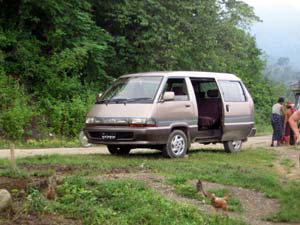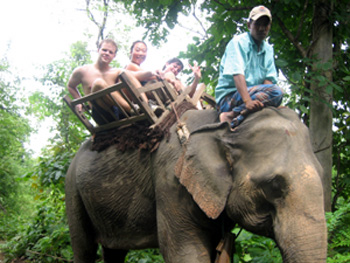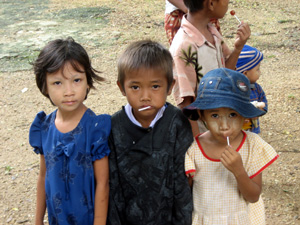TABLE
OF CONTENTS
|
Burmese Transit
By Suzanne Schefcik
I
had gotten into this gold and rusty 1981 Toyota
van expecting to see Pyay,
Myanmar
in a matter of a few hours.
Eight hours have passed and my Ipod is dying. Annoyed, I try to sleep
as we hit
pothole after pothole. As I pondered the status of our situation, I
realized
that there we nearly no other vehicles on the road. The chance of
maintenance
here really seemed slim. Governmental assistance in this area was
obsolete,
although we  passed numerous
toll booths to pay governmental fees that
were
supposedly for road maintenance. Where is this money really going? passed numerous
toll booths to pay governmental fees that
were
supposedly for road maintenance. Where is this money really going?
The
adventure began after I had looked at a complementary map of Myanmar
I found in Purser’s square.
A small picture of people riding elephants was located in the bottom
corner of
the map. I was determined to get there. Our Yangon
friend had found a couple gentlemen who ran their own travel agency who
had
agreed to take us on our journey. As we settled prices, Robert, our
travel
guide, made sure that we exchanged our cash privately in the car. By
doing so,
authorities could not see that they were making the transaction.
Apparently,
the government takes large amounts of taxes from all companies. This
way, we
were illegally helping out our friends immensely. As we stepped into
the rusty
old van, I was shocked it still was up and running. Unfortunately, the
number
of automobiles in Myanmar
is so limited it was the best they could afford. In fact, nearly all
the cars
in Myanmar
were made in the 1980s. It is very rare that Burmese citizens own their
own
automobiles.
The
amount of technological advances both in transportation and in daily
life
really showed how impoverished and behind the modern world Myanmar
remains. I had not
envisioned the country to be as primitive before our arrival. The lack
of
technology and materialism was refreshing. Although the government has
a long
way to go in order to maintain a healthy state, the country seemed
rather stable.
In accordance with Monique Skidmore in the article entitled Darker than Midnight: Fear,
Vulnerability and Terror Making in Urban Burma, “it is not
ethically feasible to conduct a detailed
ethnographic study of Burmese everyday life at this time.” I agree. The
lack of
privacy one can obtain with Burmese people limits the information one
can learn
from them. Although we were in a private car, our guide did not feel
safe
discussing certain topics in the presence of our driver. Regrettably,
we were
with the driver the entire length of our trip to Pyay, making
discussions on government,
family and daily life unavailable. As we drove on, we felt rather
distant from
our guide, but made the best of it.

As
the only car on the road driving through the mountains, we were a major
attraction. People from all over the villages would run to the road to
wave.
The sight of white people also must have been foreign to these
villagers. My
hand hurt from waving for so long, but it was really exciting to see
their
faces light up at the sight of us. Along the way, we encountered a few
stray elephants
along the road.
We
pulled up to a small village in the mountains and met our guide who
would help
lead the way through the jungle. As we hiked the muddy terrain of the
area, we
had no inkling of what was to come. We pressed on down the path and
reached
a village in the middle of the jungle. It was so crazy to see how the
people
lived.
Elephants were their only mode of transportation through the terrain.
There was
no electricity and they used the resources around them for their
survival. I
had
never seen anything like it before. Time was an issue we had to deal
with, and
we had little time to stay with the people. I was disappointed, but
also felt
privileged to see this place first hand. As we patted the elephants on
their
trunks, we took one last look at this paradise and ventured back to the
van. 
The
use of animals as the sole mode of transport reflects that Myanmar
remains
in a primitive stage of development. Along
with this, the limited
amount of
automobiles and the lack of good conditioned vehicles signify that the
country
is doing very little in order to grow technology wise. I feel that
during the
eighties, a boost in the economy and industry began, but it has long
been
abandoned. In the future, Myanmar
may have problems working to catch up with more advanced societies.
|


